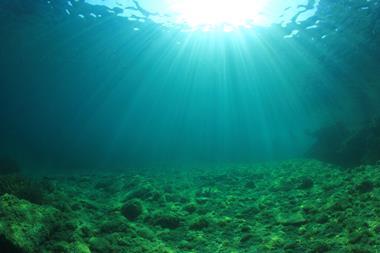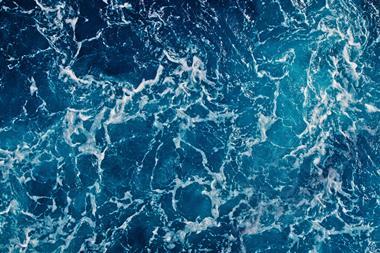
Ocean lithium concentrations declined sevenfold over 150 million years
BY FERNANDO GOMOLLÓN-BEL
CHEMISTRY WORLD

The lithium rush
Weldeghebriel explains that he and Lowenstein reconstructed historic lithium concentrations by measuring samples of ancient seawater that had remained trapped in ‘tiny pockets of halite crystals’. They then used state-of-the-art mass spectrometry to identify and quantify lithium and magnesium. It’s the ratio between these two cations that provides the detailed picture of seawater content going back in time.
‘We assume that in the ocean the ratios of the major ions are constant,’ explains Eric Achterberg, an expert in chemical oceanography at the GEOMAR Helmholtz Centre for Ocean Research in Kiel, Germany. ‘Major ions occur at high concentrations, as they’re not reactive and therefore have very long residence times in the oceans,’ he adds. ‘The [analysis] of marine halite samples from Mesozoic and Cenozoic marine evaporite basins, in combination with modelling, determined a seven-fold decrease in the oceanic concentration of lithium.’
‘This is a herculean challenge,’ says Misra. ‘They [also took] great care in excluding samples which demonstrated evidence of non-marine origin.’
The researchers explain that the concentration of lithium in seawater could relate to global climate effects, like the last ‘global cooling’ of the current geological era. Since hydrothermal vents – fissures in the seabed that discharge geothermically heated water – are a common source of lithium, Weldeghebriel suspects there is a strong link between the long-term changes in lithium concentration and tectonic activity.
‘The decline in lithium concentration in seawater is mainly associated with reduced production of oceanic crust and […] hydrothermal activity – both influenced by the movements of tectonic plates,’ says Weldeghebriel. ‘The slowdown in plate activity over the past 150 million years led to less lithium [in seawater] and [less] carbon dioxide released into the atmosphere, ultimately [creating] the current ice age.’
Because of this, Weldeghebriel notes that improving our understanding of long-term seawater chemistry will ultimately provide important insights into ‘the global carbon cycle, as well as the sources and sinks of carbon dioxide’.
References
M F Weldeghebriel and T K Lowenstein, Sci Adv, 2023, 9, 30, DOI: 10.1126/sciadv.adf1605

Fernando Gomollón-Bel is a science writer and communicator based in Cambridge, UK.
8 SEPTEMBER 2023
Analysis of salt samples has revealed that lithium concentrations in seawater have declined sevenfold over the last 150 million years. Previously, researchers had assumed the lithium concentration was constant, but the new findings may help to explain larger geological effects, including links to climate and the carbon cycle.
‘Turning back the clock by 150 million years, the Earth was warmer, with more carbon dioxide in the atmosphere and more lithium in the sea,’ explains geoscientist Mebrahtu Weldeghebriel from Princeton University in the US, who led the new research. ‘The ocean is like a giant soup of elements, [and] it’s important to understand how they respond to major changes to [deduce] the link between ocean chemistry and atmospheric chemistry.’
Weldeghebriel and his colleague Tim Lowenstein have now revealed that, despite previous assumptions, lithium concentrations in seawater have declined significantly.
Until now, the concentration of the different lithium isotopes in seawater was reconstructed from the fossils of foraminifera – a type of planktonic single-celled organisms. However, this data didn’t give a complete picture. ‘There were no robust records of the concentration of lithium in seawater, […] we only had one piece of this global puzzle,’ says Sambuddha Misra, an geochemist specialised in the reconstruction of past seawater chemistry and its connections to climate, based at the Indian Institute of Science in Bangalore, India. ‘This article provides the first quantitative reconstruction of lithium concentration of seawater through the last 150 million years,’ he adds.
Related stories
Analysis of salt samples has revealed that lithium concentrations in seawater have declined sevenfold over the last 150 million years. Previously, researchers had assumed the lithium concentration was constant, but the new findings may help to explain larger geological effects, including links to climate and the carbon cycle.
‘Turning back the clock by 150 million years, the Earth was warmer, with more carbon dioxide in the atmosphere and more lithium in the sea,’ explains geoscientist Mebrahtu Weldeghebriel from Princeton University in the US, who led the new research. ‘The ocean is like a giant soup of elements, [and] it’s important to understand how they respond to major changes to [deduce] the link between ocean chemistry and atmospheric chemistry.’
Weldeghebriel and his colleague Tim Lowenstein have now revealed that, despite previous assumptions, lithium concentrations in seawater have declined significantly.
Until now, the concentration of the different lithium isotopes in seawater was reconstructed from the fossils of foraminifera – a type of planktonic single-celled organisms. However, this data didn’t give a complete picture. ‘There were no robust records of the concentration of lithium in seawater, […] we only had one piece of this global puzzle,’ says Sambuddha Misra, an geochemist specialised in the reconstruction of past seawater chemistry and its connections to climate, based at the Indian Institute of Science in Bangalore, India. ‘This article provides the first quantitative reconstruction of lithium concentration of seawater through the last 150 million years,’ he adds.
Related stories

The lithium rush
Weldeghebriel explains that he and Lowenstein reconstructed historic lithium concentrations by measuring samples of ancient seawater that had remained trapped in ‘tiny pockets of halite crystals’. They then used state-of-the-art mass spectrometry to identify and quantify lithium and magnesium. It’s the ratio between these two cations that provides the detailed picture of seawater content going back in time.
‘We assume that in the ocean the ratios of the major ions are constant,’ explains Eric Achterberg, an expert in chemical oceanography at the GEOMAR Helmholtz Centre for Ocean Research in Kiel, Germany. ‘Major ions occur at high concentrations, as they’re not reactive and therefore have very long residence times in the oceans,’ he adds. ‘The [analysis] of marine halite samples from Mesozoic and Cenozoic marine evaporite basins, in combination with modelling, determined a seven-fold decrease in the oceanic concentration of lithium.’
‘This is a herculean challenge,’ says Misra. ‘They [also took] great care in excluding samples which demonstrated evidence of non-marine origin.’
The researchers explain that the concentration of lithium in seawater could relate to global climate effects, like the last ‘global cooling’ of the current geological era. Since hydrothermal vents – fissures in the seabed that discharge geothermically heated water – are a common source of lithium, Weldeghebriel suspects there is a strong link between the long-term changes in lithium concentration and tectonic activity.
‘The decline in lithium concentration in seawater is mainly associated with reduced production of oceanic crust and […] hydrothermal activity – both influenced by the movements of tectonic plates,’ says Weldeghebriel. ‘The slowdown in plate activity over the past 150 million years led to less lithium [in seawater] and [less] carbon dioxide released into the atmosphere, ultimately [creating] the current ice age.’
Because of this, Weldeghebriel notes that improving our understanding of long-term seawater chemistry will ultimately provide important insights into ‘the global carbon cycle, as well as the sources and sinks of carbon dioxide’.
References
M F Weldeghebriel and T K Lowenstein, Sci Adv, 2023, 9, 30, DOI: 10.1126/sciadv.adf1605

Fernando Gomollón-Bel is a science writer and communicator based in Cambridge, UK.


No comments:
Post a Comment